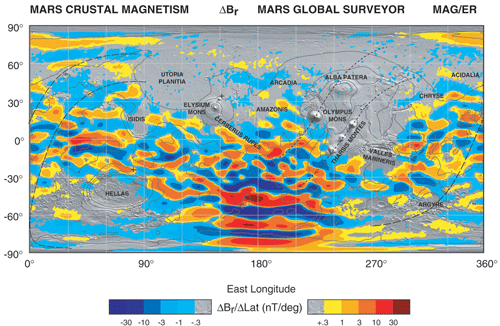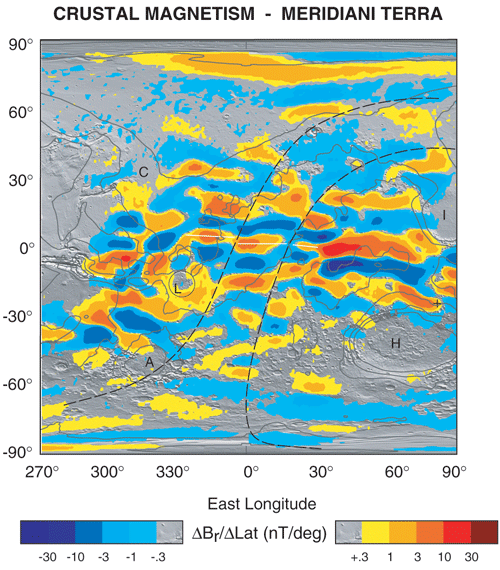A new map of Mars’ ancient magnetism, based on more than 5.5 Earth years of data, shows the Red Planet was magnetized more widely and strongly than earlier surveys indicated. The discovery also provides evidence for plate tectonics during the planet’s first half-billion years, say researchers writing in the Proceedings of the National Academy of Sciences (October 18, 2005).
“Now for the first time we can see some interesting geological effects,” says Jack Connerney of NASA’s Goddard Space Flight Center, who led the team reporting the results. The instrument used is the magnetometer on the Mars Global Surveyor spacecraft, which has been in martian orbit since September 1997. Says Connerney, “We now believe the entire crust of Mars was magnetized.”
The new mapping results, a product of continuous surveying by the spacecraft, reveal magnetic striping over most of Mars. The strongest magnetic traces are in the southern highlands, but magnetic effects have been detected in other areas as well. The two largest outstanding blank spots are the northern lowlands and the Tharsis volcanic province, home to Olympus Mons and many of Mars’ largest volcanoes.
Scientists think Mars had the ability to generate a strong magnetic field in its core during its first half-billion to 1 billion years. The martian field flipped polarity (swapping magnetic north and south) just as Earth’s magnetic field has done repeatedly. But perhaps because the martian core cooled, its magnetic dynamo shut down within a billion years of the planet’s birth.
Molten rocks that erupted while Mars’ dynamo was working have preserved the magnetic field’s polarity at the time of eruption. But magnetized rocks don’t necessarily keep their magnetic field patterns forever, explains Connerney. “You can erase the magnetic record overnight by heating a rock to 600° Celsius [1,000° Fahrenheit] — or if you can take a few million years to do the job, you only have to heat it to 300° C [500° F].”
Another discovery from the extended survey is a distinctive pattern running east-west across Terra Meridiani. This shows a repeating pattern, plus offsets at intervals, that echoes the magnetic patterns seen along Earth’s mid-ocean ridges, where the sea floor is spreading. The magnetic pattern imprints a mirror image on both sides of the spreading center.
The pattern breaks where transform faults interrupt the ridge. The faults arise from crustal stresses that build as spreading continues. “On Earth,” Connerney explains, “great transform faults that span the entire Pacific plate lie about 1,200 to 1,300 kilometers [750 to 800 miles] apart.” Those found on Mars that extend correspondingly far have roughly the same spacing.
Says Connerney, “I think this is about as clean an image of the magnetic field above a spreading center as we are likely to see from an orbiter spacecraft.” But, he continues, “If we got a Mars airplane mission, for example, we could do a nice magnetic survey, much closer to the surface and potentially do even better.”












